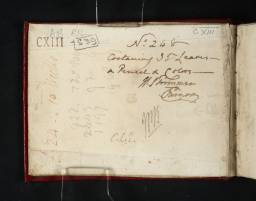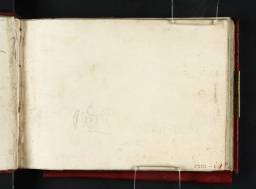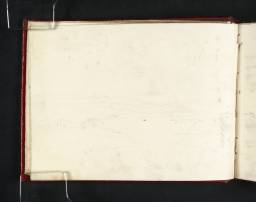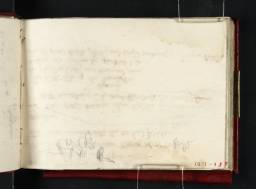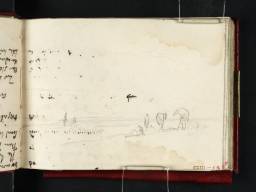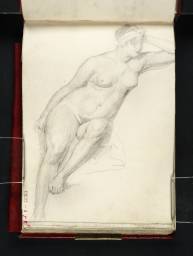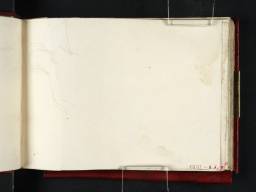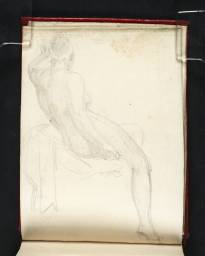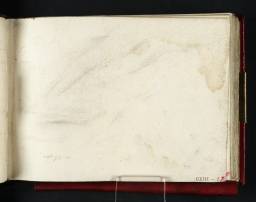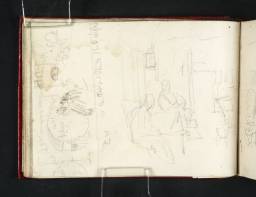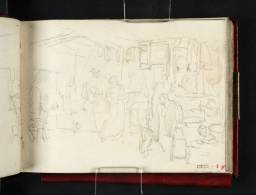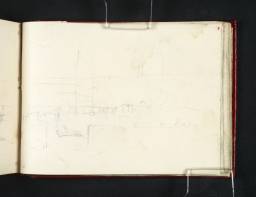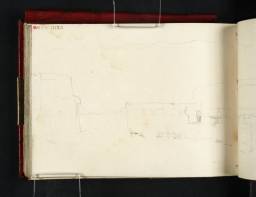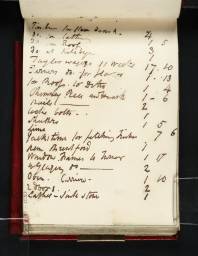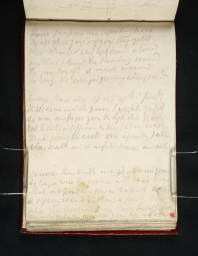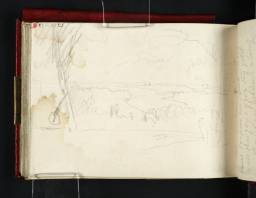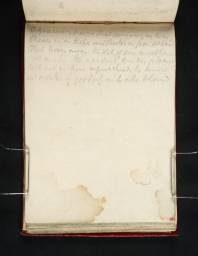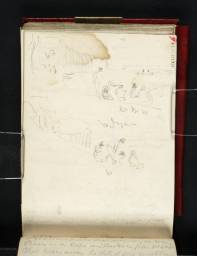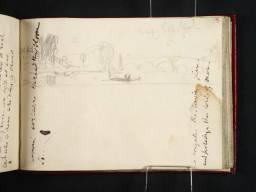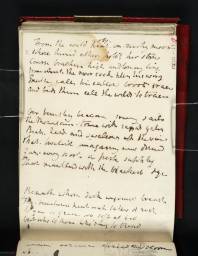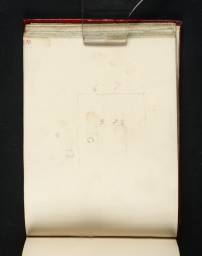Turner Bequest CXIII
Pocket book, bound in red morocco, with tooled covers, pencil holder, folding pocket edged with vellum inside front cover and one brass clasp
67 leaves of white wove paper
Approximate page size 83 x 114 mm
Made by William Balston at Springfield Mill, Maidstone, Kent
Watermarked ‘J. WHATMAN 1808’
Endorsed by the Executors of the Turner Bequest in ink ‘No 248 | Containing 35 Leaves – | in Pencil & Colour – ’, signed by Henry Scott Trimmer and Charles Turner in ink ‘H.S. Trimmer’ and ‘C Turner’ and initialled by Charles Lock Eastlake and John Prescott Knight in pencil ‘C.L.E.’ and ‘JPK’ inside front cover (D07853)
67 leaves of white wove paper
Approximate page size 83 x 114 mm
Made by William Balston at Springfield Mill, Maidstone, Kent
Watermarked ‘J. WHATMAN 1808’
Endorsed by the Executors of the Turner Bequest in ink ‘No 248 | Containing 35 Leaves – | in Pencil & Colour – ’, signed by Henry Scott Trimmer and Charles Turner in ink ‘H.S. Trimmer’ and ‘C Turner’ and initialled by Charles Lock Eastlake and John Prescott Knight in pencil ‘C.L.E.’ and ‘JPK’ inside front cover (D07853)
Accepted by the nation as part of the Turner Bequest 1856
Exhibition history
References
This small pocket book was used during Turner’s tour to the north-west of England in summer 1809, after he was commissioned to paint Lowther Castle, near, Penrith, for the Earl of Lonsdale and Cockermouth Castle, Cumberland, for the Earl of Egremont. Finberg named it for its views of Lowther, but these are few and its contents are diverse. They include a view of Whitehaven and a distant glimpse of the Isle of Man, others perhaps of the Thames Valley and of unidentified scenery, sketches of gun-dogs and sportsmen, poetry original and quoted, notes on artists and writers, accounts and plans related to Turner’s Twickenham house, Sandycombe Lodge and a series of life studies of the female nude.
Despite its name, there are only two drawings of Lowther Castle in the book, both studies of architectural details of Robert Smirke’s new Gothic pile, folios 25 and 26 (D07892, D07893). Folio 15 (D07876), tentatively identified by Finberg as a study for a picture of Lowther, appears to be unconnected with either of Turner’s paintings, Lowther Castle, Westmorland, the Seat of the Earl of Lonsdale: North-West View from Ullswater Lane: Evening and Lowther Castle, Westmorland, the Seat of the Earl of Lonsdale (the North Front), with the River Lowther: Mid-day exhibited at the Royal Academy in 1810 (private collection).1 Turner’s more finished drawings of the house and park are mainly in the Ashmolean Museum, Oxford2 and, together with views of the port of Whitehaven in other collections, came from other sketchbooks used on this tour. As Lord Lonsdale ran the port, it has been suggested that the Whitehaven subjects were acquired by him.3 In the present book, Turner drew a quick double-spread sketch of the port from the Old Quay, folios 9 verso–10 (D07868–9), and his Cockermouth sketchbook used on the same tour contains a drawing of Whitehaven Castle, the Lonsdale residence in the town (Tate D07581; Turner Bequest CX 39) as well as others of St Bees, just to the south, from where the distant view of the Isle of Man in the present book (D07926) was taken. Among the subjects newly identified here is Askham Hall, just beyond the park at Lowther across the River Lowther, folio 35 verso (D07906).
William, Lord Lowther became 1st Earl of Lonsdale (of the second creation) in 1807. A Tory politician, landowner and coal and industrial magnate, he was the patron of artists and writers including the poet William Wordsworth. In commissioning Turner he must have decided to ignore his friend Sir George Beaumont’s frequent objections to the artist’s work. However, he had followed Beaumont’s recommendation in choosing Smirke as his architect.4 The two views of Lowther reflected his pride in the new mansion, nearing completion in 1809, but the attention Turner gave to his other property and interests might indicate that more pictures were in the offing. Lonsdale often entertained artists, Henry Edridge, for example, using Lowther as a springboard for a tour of Cumberland in 1804 while Smirke, visiting Lowther and Whitehaven in 1808, accompanied his host from London and back. On his return, Smirke reported Lonsdale’s immense income and properties, energetic attention to business and passion for hunting.
The evidence of the Cockermouth sketchbook is that the business of Turner’s 1809 tour began at Lowther. There as elsewhere, Turner was witness to the life of a sporting estate. His own favourite hobby, fishing, features in several sketches in the present book, one of which might show Lord Egremont on his private jetty on the River Derwent, just below the walls of Cockermouth Castle, folio 56 (D07941). There are also various drawings of a shoot, with gun-dogs and guns, for example folios 49 verso, 51 verso, 52 verso (D07928, D07932, D07934), and passages of verse about the dangers of the grouse moor to the guns as much as to the birds. Turner seems to be writing, folio 13 verso (D07873), as a reluctant shot who has been inveigled by ‘kind persuasions’ into taking part despite his inexperience. Moreover, some sort of accident has evidently taken place and since ‘the gun too oft its owner wound’ the would-be poet bids ‘Away there all sport of the fields / Its pleasure and its pain I joyfull yield’, 14 verso (D07875).
From this Jack Lindsay inferred an ‘utmost revulsion from blood-sports’5 but Turner was a regular guest at Farnley Hall, Wharfedale, for Walter Fawkes’s shooting parties from at least 1810, having first joined one in 1808. Anne Lyles is inclined to think that Turner reused the sketchbook at Farnley in 18106 but it seems probable that he was actually there in 1809 as well, before going to Lowther. In a letter of ?August 1809 written from the Earl of Essex’s seat, Cassiobury Park, Turner speaks of ‘being now upon the wing to Yorkshire for 2 months’7 (the metaphor perhaps anticipating the grouse moor) and there are Yorkshire subjects near Farnley as well as views near Whitehaven in the contemporary Kirkstall Lock sketchbook (Tate D12240–D12260; Turner Bequest CLV). If inspired by a mishap at Farnley, Turner’s verses are oddly prophetic of the death of Fawkes’s brother Richard in a shooting accident there in 1816, while Turner was staying.
Other poetry in the sketchbook is literary in inspiration. There are rough transcriptions of Alexander Pope’s Windsor Forest and Essay on Criticism, folio 3 verso (D07859), and from the Roman satirist Persius, 28 verso (D07896), as well as a passage perhaps based on a ‘Fragment’ by Thomas Chatterton, 24 verso (D07981), the latter also touching on issues of competition and criticism (always much on Turner’s mind). As revealing of Turner’s poetic methods is a version, more a reworking than a misquotation, of Charles Cotton’s Laura Sleeping, folio 65 verso (D07955). This was published by Lindsay as Turner’s own work8 but recognised by Andrew Wilton as an instance of his habit of drafting passages from other poets as if they were his own.9 Rather than plagiarism, it suggests a literary approach akin to Turner’s assimilation of other artists in his paintings. Historical or art-historical interests are reflected in notes and extracts on figures as diverse as the Italian scribe and illuminator Petruccio Ubaldini, the courtier-poet Sir Philip Sidney and the artists Gian Lorenzo Bernini and Francesco Solimena, all on folio 21 verso (D07886), and on Albrecht Dürer, 30 verso (D07900). Perhaps Turner was browsing in a good library, at Cassiobury, Farnley or Lowther. His reading was particularly voracious at this period as he prepared his forthcoming lectures as Professor of Perspective at the Royal Academy.
The most tantalising contents of this sketchbook are life studies of the female nude, for example folio 5 (D07861). Some are coloured, and all are accomplished and intimate in character. The Executors’ endorsement records two ‘out’, perhaps a euphemism for John Ruskin’s prudish removals of alleged erotica. Those that remain are not really ‘Academy studies’ as Finberg describes them but nor, as Ian Warrell points out, are they particularly controversial either. Warrell dismisses as fanciful past suggestions that the model (who in most cases seems to be the same) might be Sarah Danby whose supposed relationship with Turner began in 1809, or her niece Hannah, his housekeeper in Queen Anne Street from about this time.10 Perhaps she was some particularly willing housemaid in a house where Turner stayed. His inscription near two figures on folio 59 (D07944), plausibly read by Finberg as ‘Woman is Doubtful Love’, has attracted much attention from scholars hunting for personal meanings or psychological insights. Other figures sketched in the book occupy rustic interiors; Turner must have drawn them during his northern tour. At least one other sketch, across folios 60 verso–61 (D07946–D07947), is of a canal barge and boatmen and was probably made on the Grand Union Canal near Cassiobury.
Of the remaining contents of the book, some may have no connection with the 1809 tour. Tiny sketches of river scenery, for example folio 16 verso (D07879), might be of the Thames and a panorama across folios 29 verso–30 (D07898–9) is inscribed as a view from Windsor. Some estimates or expenses, on for example folio 13 (D07872), and floor plans must relate to the construction of Sandycombe Lodge, Turner’s house at Twickenham for which he bought the land in 1807 and which was largely completed by 1812.11
Martin Butlin and Evelyn Joll, The Paintings of J.M.W. Turner, New Haven and London, revised ed.1984, pp.78–9 nos.111,112.
As reported by Joseph Farington, 26 April 1806; Kathryn Cave ed., The Diary of Joseph Farington, vol.VII, New Haven and London 1982, p.2735.
Turner to Charles Turner in John Gage, ed., Collected Correspondence of J.M.W. Turner, Oxford 198o, pp.34–5.
Technical Notes
How to cite
David Blayney Brown, ‘Lowther sketchbook 1809’, sketchbook, July 2009, in David Blayney Brown (ed.), J.M.W. Turner: Sketchbooks, Drawings and Watercolours, Tate Research Publication, December 2012, https://www

